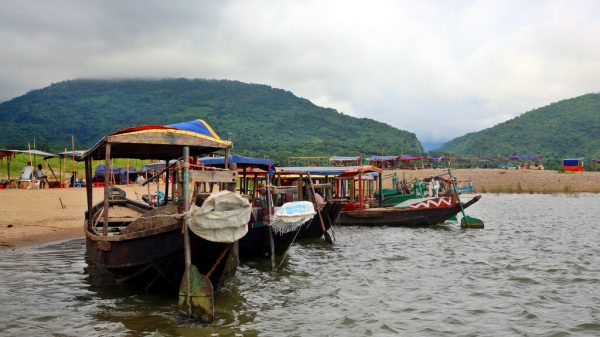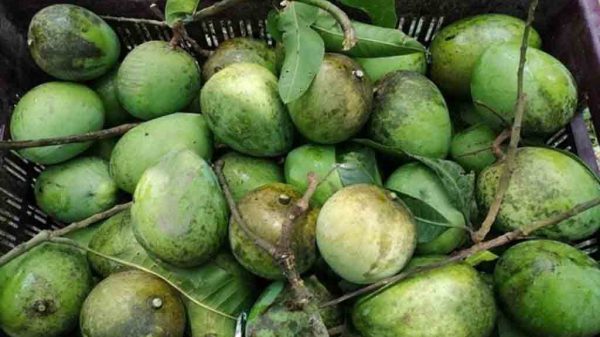Discovering scenic Sylhet: Nature’s beauty and heritage

Shawdesh desk:
Nestled in the enchanting northeast region of Bangladesh, Sylhet beckons tens of thousands of travellers every year with its mesmerising landscape adorned by lush green tea gardens, pristine swamp forests, and rolling hills.
Apart from its natural beauty and cultural heritage, this captivating destination is also blessed with meandering blue rivers and steeped in rich history, boasting an array of historical sites and revered shrines.
The newly elected mayor of Sylhet city, Anwaruzzaman Chowdhury, shared with New Age Business magazine his perspective on the region’s tourism prospects, emphasizing the significant potential for further growth.
‘The tourism sector in the Sylhet region holds immense promise as it possesses nearly all the essential elements crucial for the development of tourism in any country,’ he said.
‘Now, our focus should be on harnessing this boundless wealth and potential… it is imperative that we effectively promote our tourist destinations … our illustrious history … our rich culture to both local and foreign visitors,’ he remarked.
M Naser Rahman, the owner of DuSai Resort and Spa, mentioned that tourists have been a constant presence in the Sylhet region, with their numbers now steadily increasing.
‘There has been a surge in local tourists visiting Sylhet; however, he expressed that the number of foreign tourists remains less than desired due to the shortcomings of Bangladesh Parjatan Corporation,’ he said.
Sylhet is situated in the northeastern region of Bangladesh, bordered by Meghalaya State of India to the north, Tripura and Mizoram States of India to the south, Assam of India to the east, and parts of Dhaka, Chattogram, and Mymensingh divisions of Bangladesh to the west.
The mere touch of the feet of great Muslim saints has bestowed upon this region an indescribable atmosphere of spiritual tranquillity.
In addition to the sacred shrines of Hazrat Shahjalal (R) and Hazrat Shah Paran (R), who arrived here approximately 1,200 years ago from the distant Middle Eastern country of Yemen to spread the teachings of Islam, Sylhet, encompassing four districts — Habiganj, Moulvibazar, Sunamganj, and Sylhet — also beckons visitors to the ancestral home of Shree Chaitanya Dev, a Hindu saint who advocated non-communal ideals in the subcontinent and opposed the caste system among his religious community.
The melodies of nature harmoniously resonate in the voices of the people who have grown up in close communion with nature in this region.
Thus, the lyrical tunes of poets like Hasan Raja, Radharaman, Shitalong Shah, and Shah Abdul Karim effortlessly emanate from the banks of the Surma, Kushiara, Khowai, and Kalni rivers in this captivating locale.
Among the fascinating tourist attractions of Sylhet district, often referred to as the ‘daughter of nature,’ the lush and expansive tea gardens that sprawl on the city’s outskirts deserve special mention.
Upon approaching the city’s outskirts, one is greeted by the sight of neatly aligned tea gardens.
The eyes of any tourist are invariably drawn to the scene of women diligently plucking tea leaves in the picturesque Lakkatura, Malnichhara, and Tarapur tea gardens.
Additionally, Jaflong, situated in Goainghat upazila, approximately 62 km northeast of Sylhet city, stands out as the most beloved tourist destination in Sylhet.
Nestled at the base of the Khashia-Jainta Hills of India’s Meghalaya State, Jaflong boasts a captivating landscape where cascading streams from the Khasia Jainta Hill flow into the Piyain and Dauki rivers, leaving behind a multitude of colourful pebbles on their riverbeds.
From a distance, this scenery creates the illusion of mountains touching the sky, with billowing clouds adding to the mesmerising vista.
Such a splendid display of nature’s beauty is a rarity, and Jaflong offers it in abundance.
The area also features Khasia tribal villages and betel nut leaf gardens, making it a comprehensive and enticing destination that draws tourists from all corners of the country year-round.
A visit to Jaflong also provides opportunities to explore nearby attractions, including Sada Pathar in Bholaganj, the charming fountain in Sreepur, the emerald-green water stream of River Lalakhal, the serene Tamabil Green Park, and Panthumai, a captivating blend of hills, rocks, and rivers.
The exploration of Sylhet’s natural beauty remains incomplete without a visit to the Ratargul Swamp Forest, the only freshwater swamp forest in South Asia.
Furthermore, during the monsoon season, the mesmerizing waves of crystal-clear water stretching across the vast expanse of Hakaluki Haor, the largest haor (wetland) in the country, have the power to captivate the heart of anyone fortunate enough to witness them.
Moulvibazar is renowned as the capital of tea gardens in the country and stands as a prime destination for nature-loving tourists.
This district is home to an impressive 153 out of the total 167 tea gardens in the country, making it the ultimate destination for immersing oneself in the undulating waves of greenery gracing the hillocks.
No visit to the Sylhet region is complete without exploring the treasures of Moulvibazar, including the Lawachhara National Park, the Bangladesh Tea Research Institute compound, Madhabkunda, and Humhum waterfalls, all of which are teeming with biodiversity and natural beauty.
Madhabkunda, the largest waterfall in the country, cascades gracefully from the heights of the Patharia hill in Baralekha upazila of Moulvibazar.
Beyond the refreshing touch of the waterfall, tourists are captivated by the lush, green Patharia hill.
The Madhabkunda Eco Park offers breathtaking views, with dense forests, idyllic picnic spots, expansive mountain valleys, and the soothing sound of water rushing down the rocky terrain, all combining to create a heavenly experience.
Another highlight here is Parikunda, a nearby fountain accessible with just a 20-minute walk from Madhabakunda.
For the new generation of tourists, a visit to Humhum waterfall, ensconced within the dense forests of Kamalganj upazila in Moulvibazar, is an irresistible attraction.
The Bangladesh Tea Research Institute is located in Srimangal upazila, and exploring its compound is a must to admire the vibrant gardens of colourful flowers, the collection of rare herbal plants, the tea testing laboratory, and the various indigenous tea plant species developed in the country.
Lauachhara National Park stands as another enchanting spot for nature enthusiasts, boasting 167 species of rare trees, 4 species of amphibians, 6 species of reptiles, 20 species of mammals, and 246 species of birds. Located in Kamalganj, tourists can hire local guides to enhance their experience and ensure safety.
Moulvibazar offers quality accommodation options at different locations, including Grand Sultan Hotel, Dusai Hotel, Rangauti Resort, and Lemon Garden, providing comfortable stays for visitors exploring this picturesque region.
In Sunamganj, the sheer beauty of nature unfolds through its vast water bodies. Tangoar Haor, recognised as the second ‘world heritage site’ of Bangladesh by UNESCO, is often referred to as a ‘mini sea’ by tourists.
Its allure is so strong that tourists eagerly traverse inaccessible paths to witness the captivating beauty of the River Zadukata and Barektila in Tahirpur upazila within the district.
Tangoar Haor, sprawling over approximately 100 square kilometres and encompassing Tahirpur and Dharmapasha upazilas, stands as one of the largest habitats for migratory birds. Each year, it welcomes an average of 20 to 25 lakh migratory birds.
Moreover, Tangoar Haor is a sanctuary for biodiversity, hosting 200 species of birds, 140 species of fish, 150 species of reptiles, over 100 species of invertebrates, and more than 12 species of frogs.
For heritage enthusiasts, Sunamganj offers additional attractions, including Hasan Raja’s home and mausoleum in Laxmanshree on the outskirts of the town. The 800-year-old palace of the former Laur State in Taherpur upazila is another captivating destination that draws heritage seekers with its historical significance.
The Teliapara Tea Garden in Madhavpur upazila of Habiganj holds a significant place in the history of our liberation war.
On April 4, 1971, the first meeting of freedom fighters took place in the manager’s bungalow of this tea garden, and General MAG Osmani led 27 retired army officers and officers of the East Bengal regiment in this historic gathering to liberate the motherland.
During this meeting, a momentous decision was made to divide the entire country into 11 sectors, a critical step in the liberation war.
To honour the memory of these freedom fighters, a bullet-shaped monument was erected in the Teliapara Tea Garden. This monument continues to attract people from across the country and abroad and the visitors often pay tribute to the war heroes by placing floral wreaths.
Satchhari National Forest in Chunarughat upazila of the district is one of Bangladesh’s renowned tourist destinations. Thousands of tourists visit Satchhari daily to experience the biodiversity and the stunning beauty of its plants.
Guided eco-tours allow visitors to discover rare trees, a variety of unique animal species, and extraordinary birds such as Shyama, Moyna, Basanti Bauri, Fotakanthi, and Satbail within the forest’s lush surroundings.
The forest is also home to small ethnic groups, and visitors can learn about their diverse lifestyles with a friendly approach.
For accommodations, tourists can choose The Palace Hotel and Resort located along the Dhaka-Sylhet highway in Bahubal upazila or any of the options available in Sylhet city.
Tourism experts believe that the potential for developing the tourism industry in the Sylhet region remains largely untapped.
They argue that foreign tourists are not being attracted due to inadequate communication systems, poor infrastructure, and a lack of strategic initiatives to boost the industry.
Afzal Rashid Chowdhury, president of the Sylhet Metropolitan Chamber of Commerce and Industry, highlighted the pressing issues faced by tourist spots in the Sylhet region.
He said that a severe shortage of clean washroom facilities and the absence of quality food options are the main challenges.
Many of these locations lack proper restroom facilities, and those that do exist are often unsanitary and unusable.
He observed that addressing these two critical problems promptly would likely lead to an increase in the number of local and foreign tourists visiting the tourist destinations in the Sylhet region.
Naser Rahman further expressed his disappointment, noting that the Parjatan Corporation has yet to implement effective measures for promoting and expanding the tourism industry.
He further said, ‘Government officials are not effectively managing the tourism sector and suggested that greater involvement of private sector investors is necessary to enhance the country’s tourism industry.’























Leave a Reply